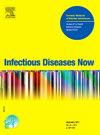Vaccination coverage against three viral sexually transmitted diseases, among 18-to-30-year-olds seen between May 2023 and May 2024 in the Martinique University Hospital CeGIDD
IF 2.2
4区 医学
Q2 INFECTIOUS DISEASES
引用次数: 0
Abstract
Objective and Methods
: We retrospectively assessed protection against HBV (defined by HBs Ab > 10 UI/L), HAV (defined by positive IgG), and HPV (defined by at least one shot) in 1161 patients aged 18–––30 years old who consulted at an HIV and STI screening center (CeGIDD) between May 2023 and May 2024. Results are presented by gender, sexual orientation and PrEP use.
Results
All in all, 59% (621/1051) of the population was HBV-immune. Among MSM, bisexual men and transgender people, 17% (18/105) were HAV-immune, a proportion rising to 40% (42/105) at the end of the study period. Among PrEP patients, 18% (13/78) were HAV-immune and 64% (50/78) were HBV-immune. HPV vaccination was given to 12% (68/569) of women, 13% (72/583) of men, 37% (54/147) of MSM, bisexual men and transgender patients, and to 41% (32/78) of PrEP users.
Conclusion
All health workers should be fully aware of the relevant recommendations and actively involved in enhancing patient protection.
2023年5月至2024年5月期间在马提尼克大学医院(CeGIDD)接受治疗的18至30岁人群中,三种病毒性性传播疾病的疫苗接种覆盖率
目的和方法:我们回顾性评估对HBV的保护作用(定义为HBs Ab;2023年5月至2024年5月期间在艾滋病毒和性传播感染筛查中心(CeGIDD)咨询的1161名18 - 30岁患者中,HAV(由IgG阳性定义)和HPV(由至少一次注射定义)的感染率为10 UI/L。结果按性别、性取向和PrEP使用情况分列。结果总体而言,59%(621/1051)的人群具有hbv免疫。在男男性行为者、双性恋者和变性者中,17%(18/105)对甲肝病毒免疫,在研究期结束时这一比例上升至40%(42/105)。在PrEP患者中,18%(13/78)具有甲型肝炎免疫,64%(50/78)具有乙型肝炎免疫。12%(68/569)的女性、13%(72/583)的男性、37%(54/147)的男男性接触者、双性恋男性和变性患者以及41%(32/78)的PrEP使用者接种了HPV疫苗。结论所有卫生工作者应充分了解相关建议,并积极参与加强患者保护。
本文章由计算机程序翻译,如有差异,请以英文原文为准。
求助全文
约1分钟内获得全文
求助全文
来源期刊

Infectious diseases now
Medicine-Infectious Diseases
CiteScore
7.10
自引率
2.90%
发文量
116
审稿时长
40 days
 求助内容:
求助内容: 应助结果提醒方式:
应助结果提醒方式:


